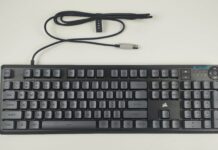Worth It?
Review Summary
Aula F65 is a good budget keyboard but not quite the homerun we’ve come to expect from Aula. While the fundamentals are all there, the clunky software and unimpressive wireless performance let it down. Regardless, it sounds great with the same excellent stock stabs and premium keycaps. If all you want is a solid keyboard that types well and you’re set on the 65% form factor, the F65 is still a reliable choice.
Hours Tested: 1 week
Overall
-
Build Quality - 8/10
8/10
-
Design - 7.5/10
7.5/10
-
Features - 8/10
8/10
-
Typing Experience - 9/10
9/10
-
Performance - 7/10
7/10
-
Value - 8/10
8/10
Pros
- Clean and minimalist design
- Solid build quality with some heft
- High-quality switches; creamy sound
- Thick doubleshot PBT keycaps
- Great factory-lubed stock stabilizers
- Vibrant RGB and reactive audio effect
- Dedicated storage for 2.4GHz dongle
- Gasket-mounted with plenty of dampening
Cons
- Subpar wireless performance
- No extras or novelty features
- Not the most intuitive software
- No height adjustment
Aula has produced some of the most well-reviewed budget keyboards of the past year. The F75 has become downright legendary in its status, joining the likes of the TM680 and GMK67 as the most prolific options in this class, boards that dictated or changed the status quo for everything else around them.
Now, Aula is back with their latest entry in the F-series with the Aula F65. A new keyboard that looks to build upon the gargantuan success of its older brothers — the Aula F75 and the Aula F87 Pro. So, is this a faltering attempt by Aula to grasp a previously unexplored niche, or does it have enough to stand among the greats?
Key Takeaways
- The Aula F65 is a competent budget keyboard from a recognizable brand that brings forward a lot of the same great features found in its contemporaries.
- Buy the Aula F65 if you’re looking for a well-built 65% keyboard that’s affordable without compromising on the basics like sound and feel.
- Avoid the Aula F65 if wireless performance is imperative to your playstyle and you can’t adjust to unrefined software.
What Makes The Aula F65 Stand Out?
The Aula F65 is a bog-standard mechanical keyboard with no features that make it unique except for the Aula brand name. That brings a lot of goodwill and thankfully the F65 doesn’t dishonor that legacy. You’re getting high-quality switches, keycaps, and stabilizers here, paired with a well-built case that feels better than it costs.
Unboxing Experience
The Aula F65 comes in a straightforward no-frills box with plenty of branding all over. This is another one of the Epomaker branded Aula keyboards, so it’s called Epomaker x Aula F65 but make no mistake, Aula is the one who made this while Epomaker is just a distributor. Anyhow, there are tabs on either side of the box to get in.
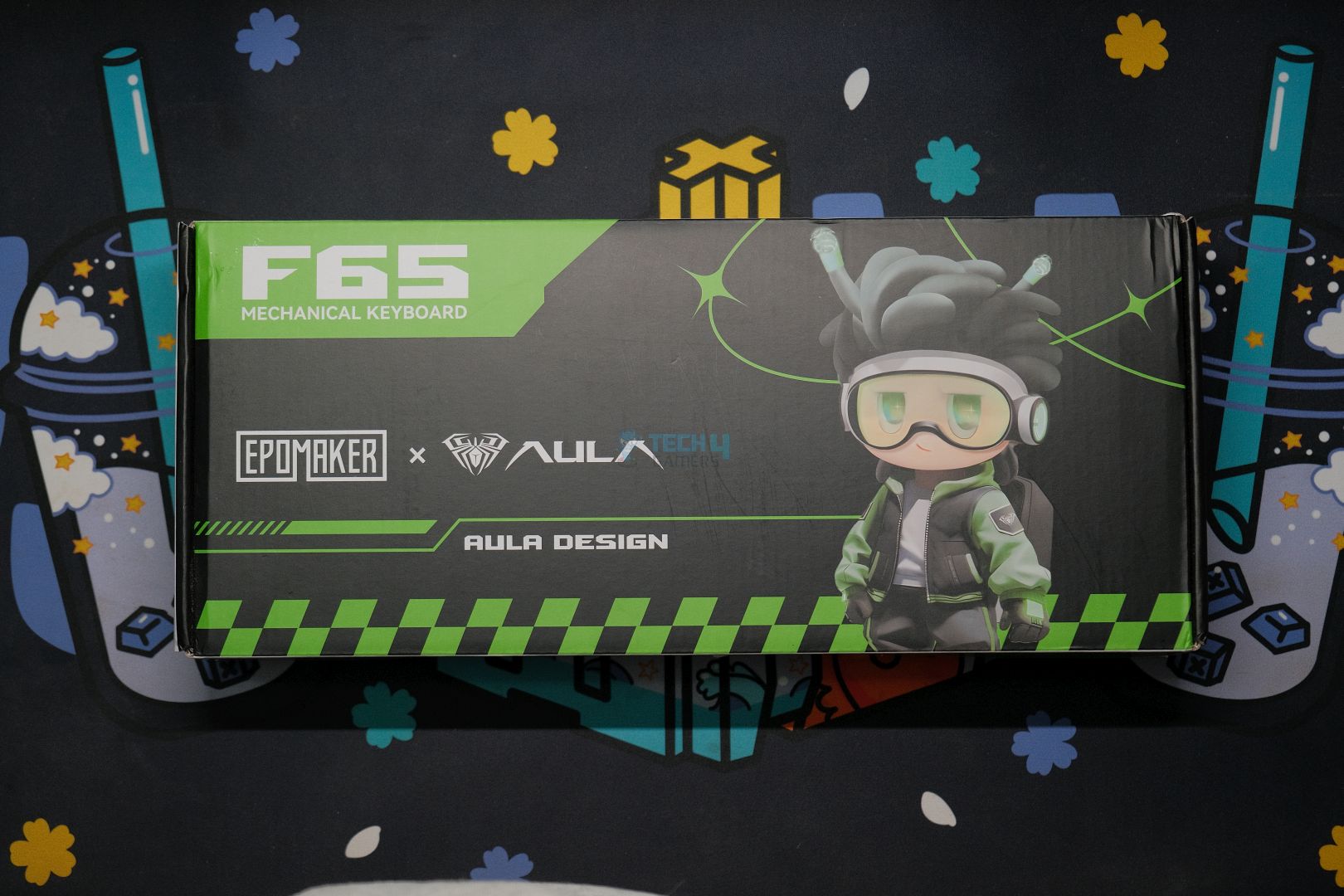
Once inside, you’ll be greeted to the manual and instructions card with the board sitting underneath, wrapped in plastic. No dust over provided. The accessories lie isolated at the top in their own section aptly labeled “Additional Accessories” but with a rather nice-looking font and some arrows, strange detail I know but I liked it.
Here’s everything you get in the box:
- 1x Aula F65
- 1x Keycap/Switch Puller
- 1x USB-C Cable
- 2x Extra Switches
- 1x Instructions Card
- 1x Manual
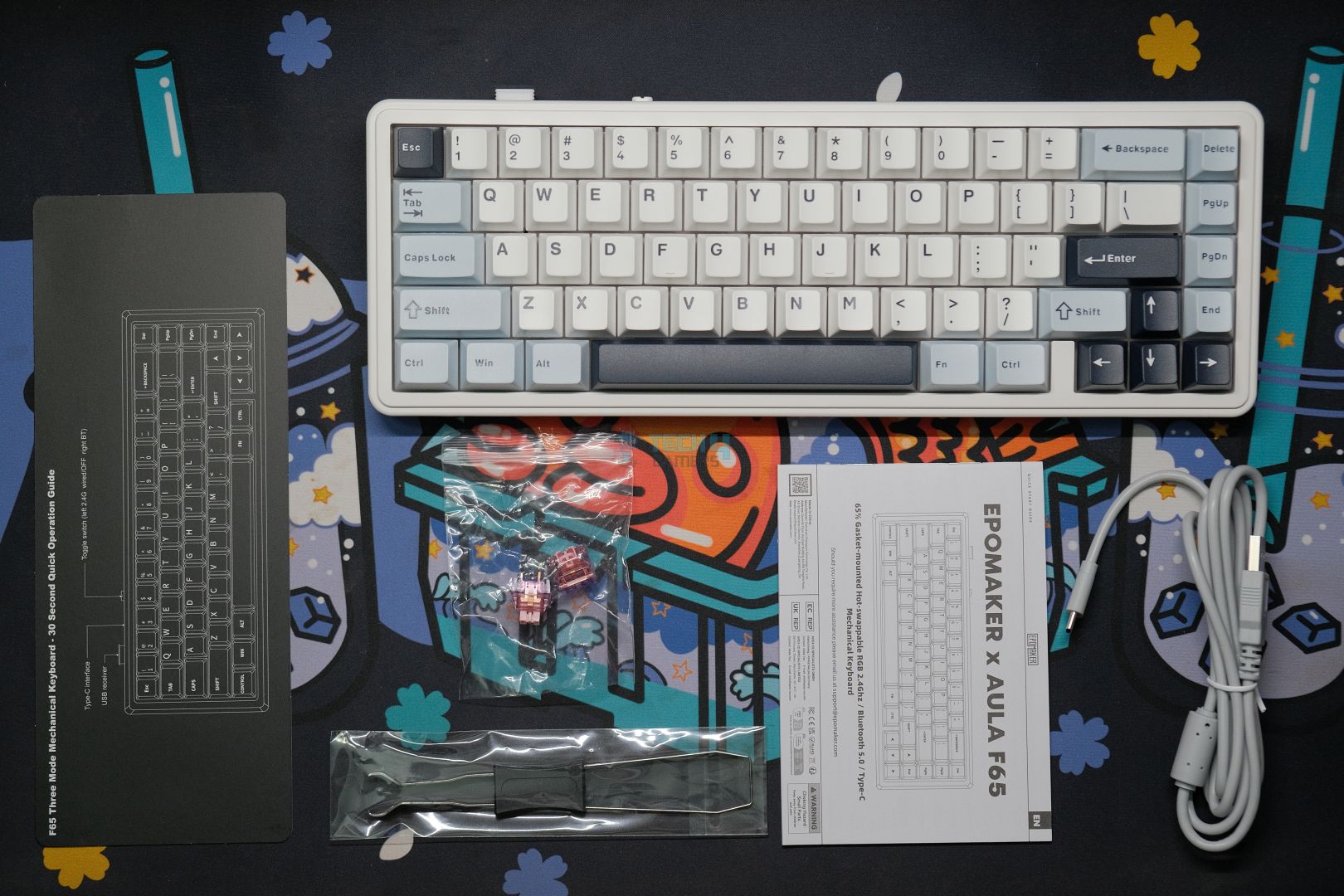
Build & Design
The Aula F65 looks eerily similar to all the other Aula F-series boards, as it should. We have the classic white and blue colorway, which is identical to the same colorway on the Aula F75 and F87 Pro. The board is made out of plastic but doesn’t feel cheap at all and there’s no case flex or creaking either. It’s not as heavy, though, at only around 800 grams.
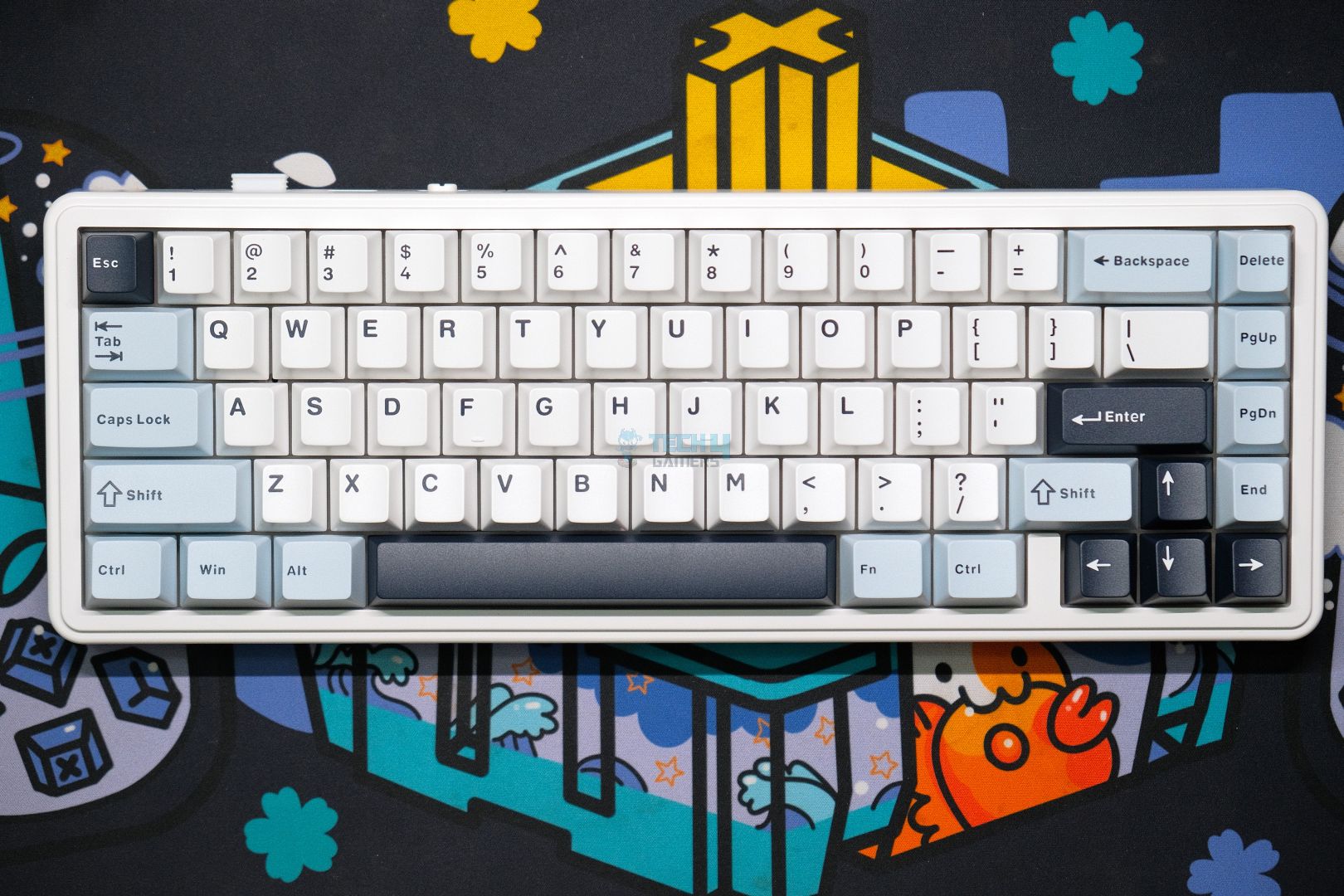
The entire front of the board has a lip going around the perimeter, once again akin to the F75, and it adds a bit of flair to the board. The bezels are even, which I appreciate, and there are no indicator LEDs or printed symbols anywhere. The typing angle here is 6.5 degrees, with a front height of about 20mm. Toward the top, there’s even a dedicated magnetic slot for the USB receiver right next to the USB port and the connection switch.
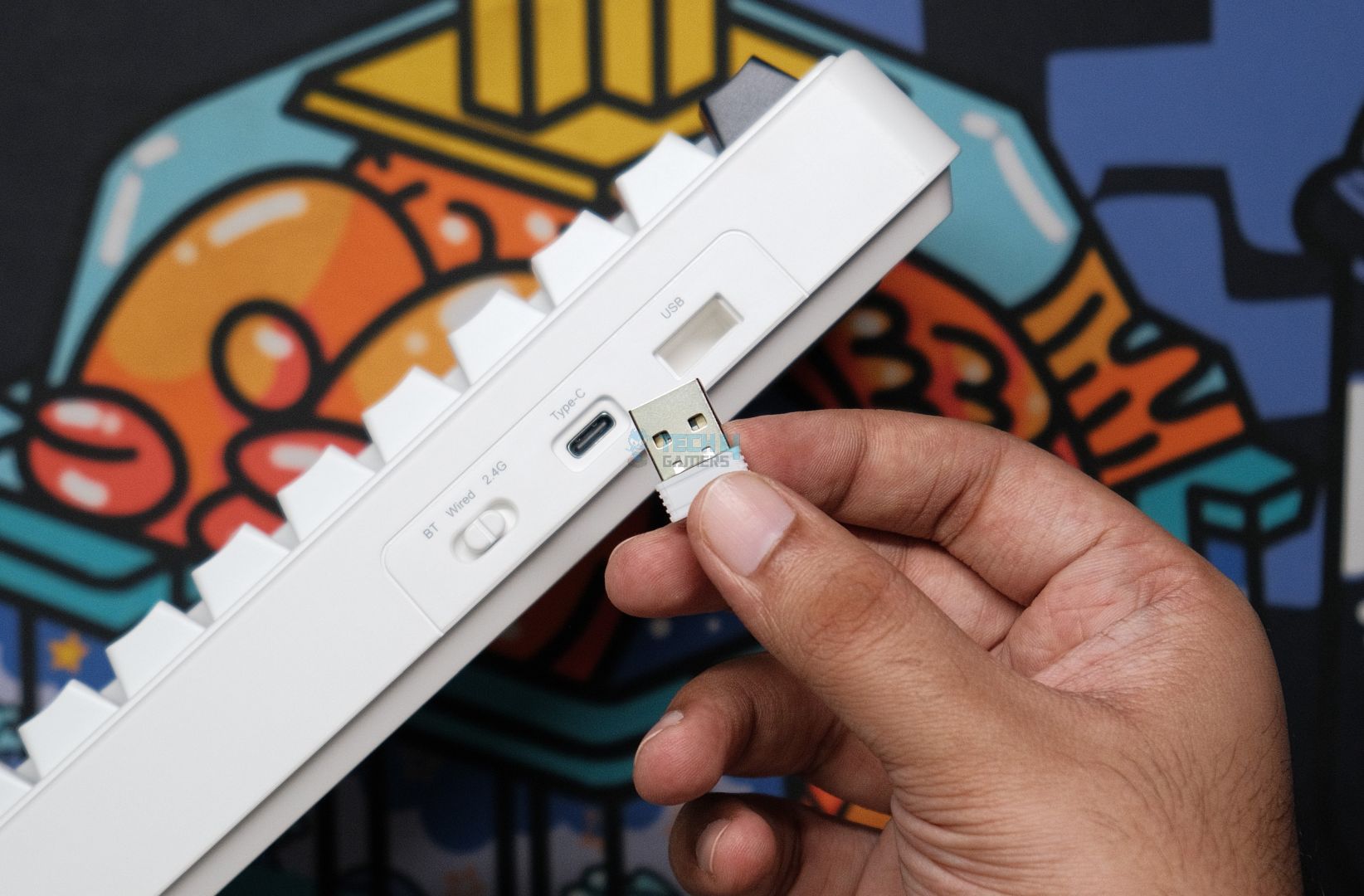
The side profile is somewhat fancy with RGB strips running down on both sides and they’re diffused very well. There’s a subtle downthrow from these lights onto your desk which is only visible in dark conditions, but it still looks nice. The plastic has a layered look such that it appears to peel back to reveal the RGB before curving downwards into the back of the case.
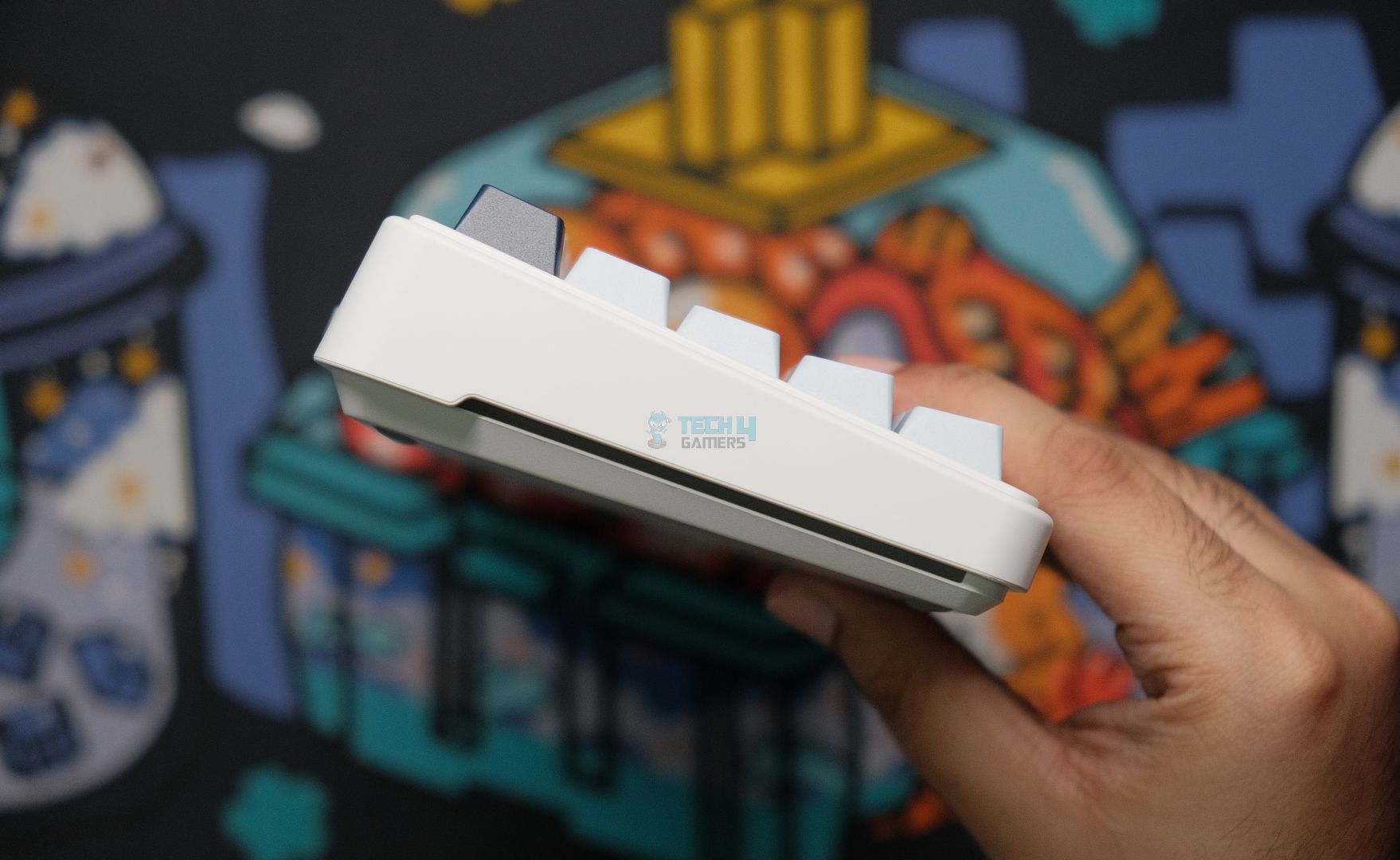
Speaking of which the back is very simple with no flip-out feet and an Aula logo sticker in the middle. The case is constructed curve outwards into the side profile which then joins the top so, in a way, it gives the board a floating look from the front. Overall, a sleek aesthetic that’d work in both casual home environments and professional office ones.
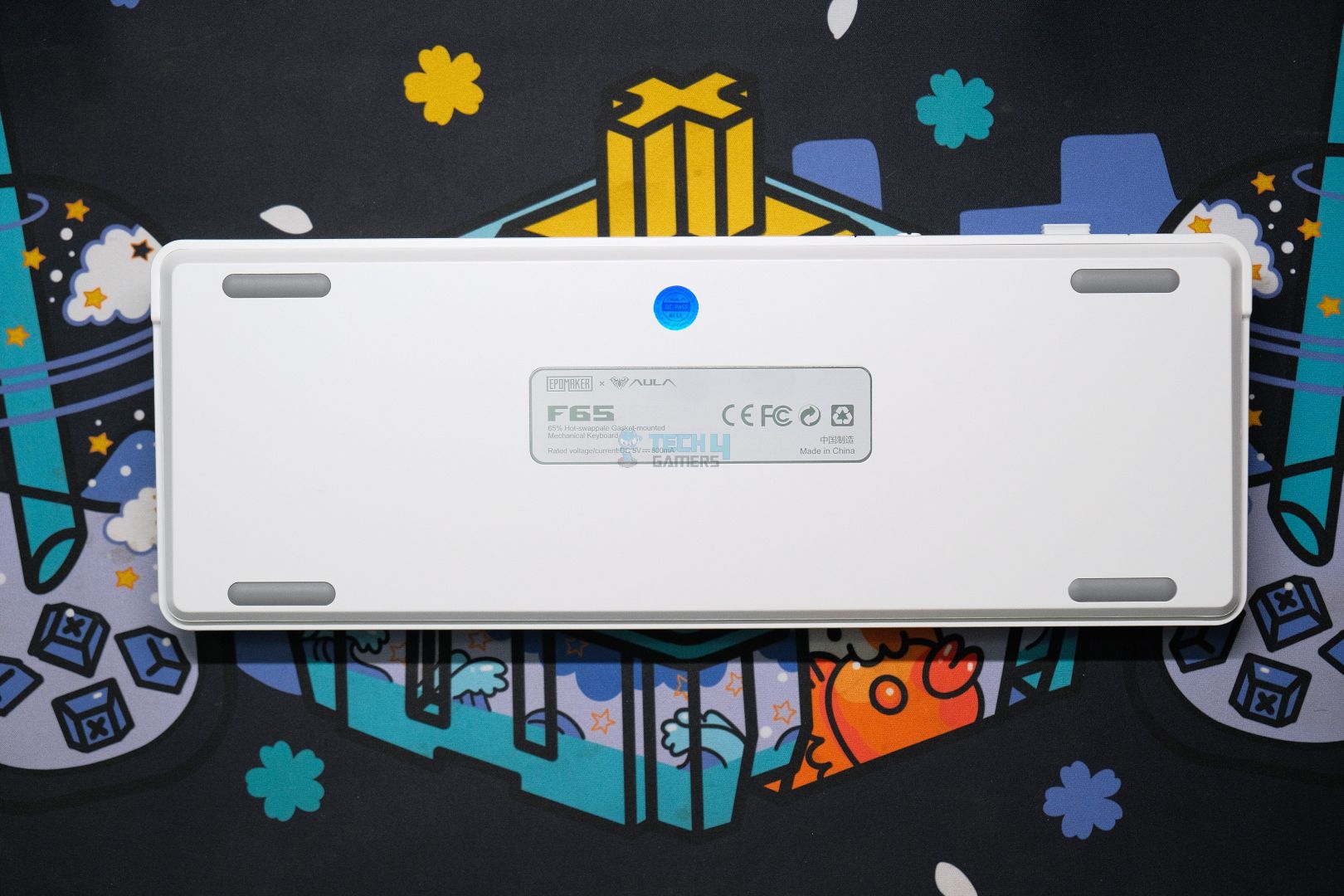
Layout & Features
Aula F65 is a wireless keyboard—through both 2.4 GHz and Bluetooth—sporting a 65% layout. It’s fully hot-swap with south-facing sockets that support per-key RGB. There is no knob, screen, or any other gimmick, which is a nice change of pace, but it does mean less surface-level value compared to Aula F75 or something like the Epomaker Shadow-X.
The board is gasket mounted using little silicone beans that sit on the edges of the plate. They’re not soft so the typing experience isn’t exactly bouncy. More on this later. The plate is made out of polycarbonate and has a lot of flex cuts, just like the PCB which is only 1.2mm thick and has no extra layout options like ISO support or stepped caps.
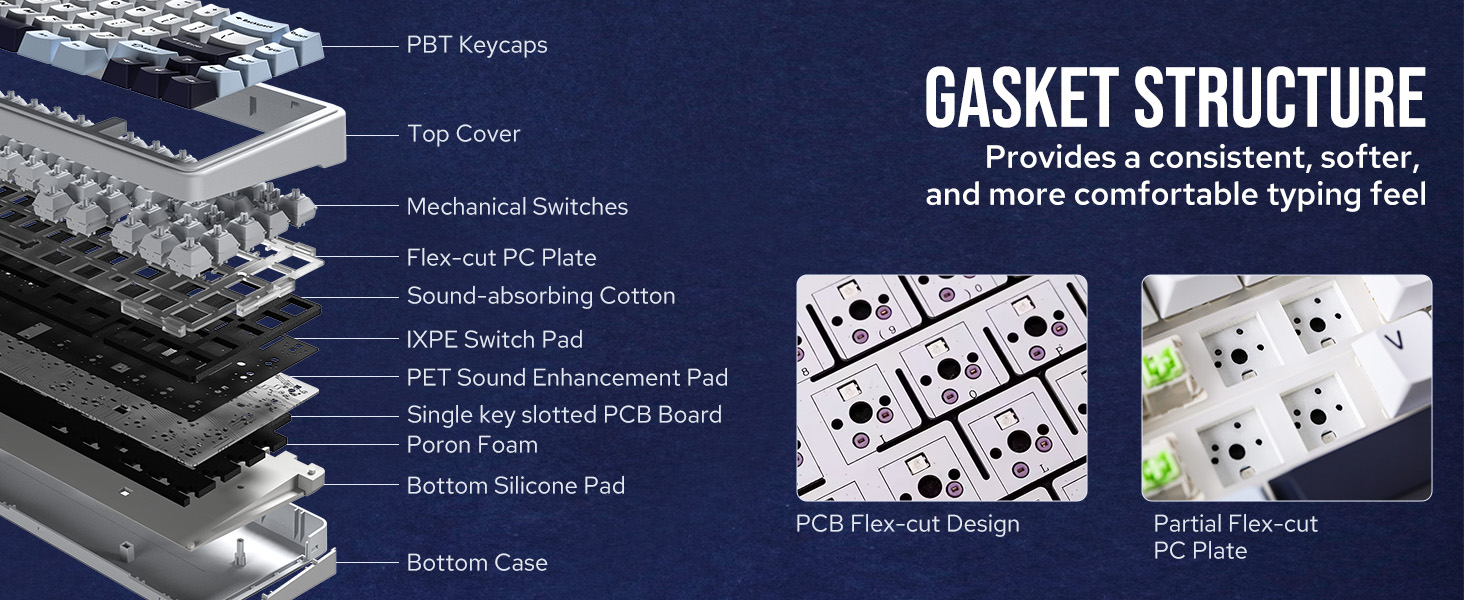
There’s plenty of foam inside to dampen everything. You get your standard affair of plate foam, the IXPE sheet and some bottom PCB foam (like a pseudo tape mod). There is also a PET sheet included which boosts the high-end frequencies. Lastly, there’s some foam underneath the PCB along with a silicone pad in the very bottom of the case.
The Fundamentals
Now let’s talk about the parts that make up the sum of the Aula F65 and judge whether it’s worth it or not.
Switches
The Aula F65 comes in three different switches: Leobog Reaper, Leobog Graywood V3 and Epomaker Flamingo; all linears but we have the Flamingos in our unit. These are 47g switches with a bottom out of 60g, so they feel light and snappy. The dual-stage spring ensures the stem shoots back up quickly after the key is pressed.
These switches are factory-lubed with good consistency, and I don’t hear any spring ping, but there is a subtle hint of crunch, especially if you hit it hard. They also have noticeable stem wobble that is likely exacerbated due to the box-style stem with walls. This is not a big deal by any means and is unbothersome in regular typing.
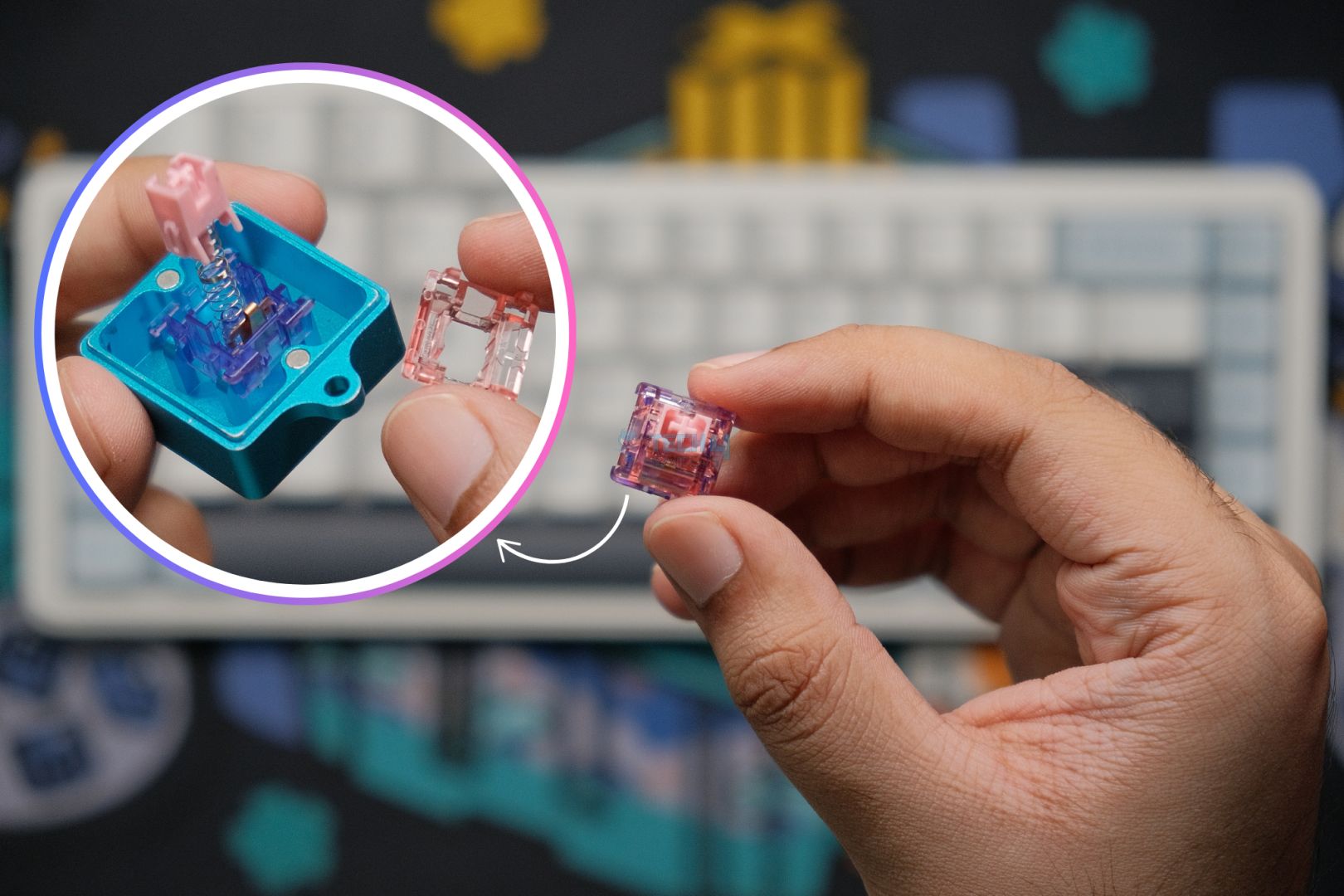
Overall, these are solid linears with a creamy sound signature that leans towards that “thock” many beginners want. But it’s not quite as deep or low-pitched, which I actually appreciate. I tried them in a foamless Lucky65 build with GMK keycaps, and they sounded quiet with an increased spring crunch. Aula did a good job pairing them with a foamed-up board.
Keycaps
The F65 comes with the same great doubleshot PBT keycaps found in other Aula boards. They’re thick, made out of PBT, have clear and sharp legends with no imperfections. It’s a standard Cherry profile so quite comfortable but keep in mind there are no extras in the box.
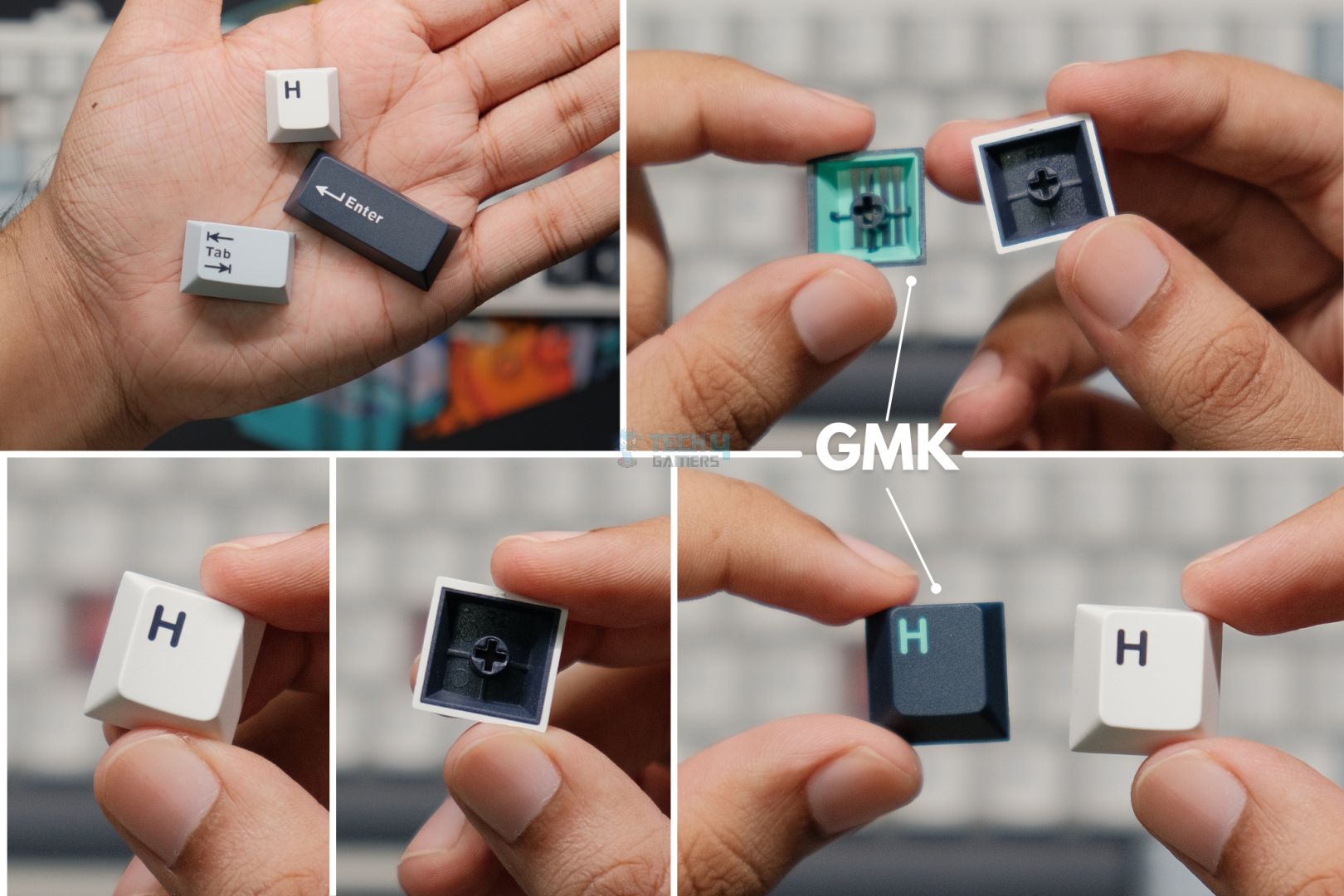
Compared to GMK keycaps, they have a much smoother texture with a less gritty appearance. Sound-wise they fit the deep, low-pitched crowd pretty well, but they’re not too far gone like MOA or MT3 and certainly not as clacky as ABS. Just some high-quality keycaps that you won’t need to switch out anytime soon.
Stabilizers
Just like we see on other Aula boards, the F65 has plate-mounted stabs that come pre-lubed from the factory and they’re virtually perfect. There is no rattle or ticking and they have a nice, consistent bottom out. The Enter key is significantly thockier than all the other stabs. There is also no support for PCB-mounted stabs, not that you’ll ever need them.

Performance & Connectivity
You can use the Aula F65 wired through USB-C or wirelessly through Bluetooth and 2.4Ghz radio. For competitive gaming, I’d suggest plugging in as the wireless latency is quite high and I did feel just a slight bit of lag. There were no disconnection issues. The wired latency is much better and feels perfect for both typing and playing.
Aula has put a 4000mAh battery inside the F65 and it lasts all day with the RGB on. Without the RGB, you can expect about a week of usage before it dies. The battery life is on par with other budget boards in this segment and tends to trail on the higher side actually. Charging the board from 0-100 takes about 7 hours.
Typing Experience
The board has a creamy sound signature but it’s not dead, like I can still hear the switches, and that extra bit of added liveliness is what makes like Aula’s boards the most in this category. They don’t go for a completely muted sound but rather a rounded-off sound that’s more mature.
Epomaker also sent us two extra switches along with the F65: Epomaker Wisteria and Leobog Reaper. Both of them come packaged in a jar, but the Wisterias have their own box on top. They share mostly the same specs, too, both 47g factory-lubed linears with a standard spring that allows for 3.6mm of total travel.
I was significantly impressed with the Wisteria switches and their smoothness. They felt like a louder MMD Princess linear and certainly an upgrade over the Flamingos. All that spring crunch was gone, reduced stem wobble, and an uber-satisfying creamy sound. These feel a bit lighter due to the less initial force required to actuate them.
The Leobog Reapers, on the other hand, are more similar to the Flamingos. Still, their use of a standard spring and tighter housing allows them to sound better. They feel a bit lighter as well due to the 55g bottom out force instead of the 60g on the Flamingos. Overall, it’s another great option that you can also buy separately for pretty cheap.
The Software
The software experience of the Aula F65 is interesting to say the least. You can easily get it from Epomaker’s site and one thing I immediately liked was that it works in the wireless mode as well; you don’t need to be plugged in like most other budget boards.
The UI is clunky, not very polished but not terrible either. You do get all the features you need though, like key mapping, macros, plenty of RGB effects and even finer adjustments like debounce delay, which is great. The RGB isn’t controllable per-key and every change needs to be saved (which takes 3 seconds) before you can see it on the keyboard.
There is an additional tab for audio effects where the board will pick up system audio and have the RGB react to it. There’s a bunch of different effects to choose from, all of them are distinct on paper but on the board itself the transitions between each LED are somewhat abrupt even after maxing out the smoothness slider.
Another issue I noticed that you have to be very specific with these audio effects. If you have one running, you must turn it off first before switching to another or else the software will crash. Changing between them also takes a bit longer than I’d like and you cannot control the brightness here like with standard RGB effects, but you can pick the colors.
Overall, this is far from the maturity you’d see in something like Wootility or the deep integration in Synapse, but it’s better than nothing. I’ll put this on par with the software Weikav bundles with the Lucky65 V1. The great thing is you won’t need to use it much as all the RGB is configurable through Fn key shortcuts, like on every other board ever, and the Epomaker co-branding at least helps produce nicer manuals to help with that.
Should You Buy It?
Buy It If:
✅You want a well-rounded 65% keyboard on the budget that sounds and feels good without cutting any corners in build.
✅You prefer minimalistic designs that stick to the classic formulas instead of muddying up the aesthetic.
✅You’re a beginner looking to enter the keyboard hobby. The Aula F65 is a great start that can open up more opportunities thanks to its hot-swap PCB and standard layout.
Don’t Buy It If:
❌You’re a competitive gamer looking for a wireless keyboard that doesn’t break the bank, as the latency is on the higher side.
❌You want something extra like a screen or a knob to spice up the simple layout and get more value out of your purchase.
❌You appreciate good software as the experience here is underwhelming.
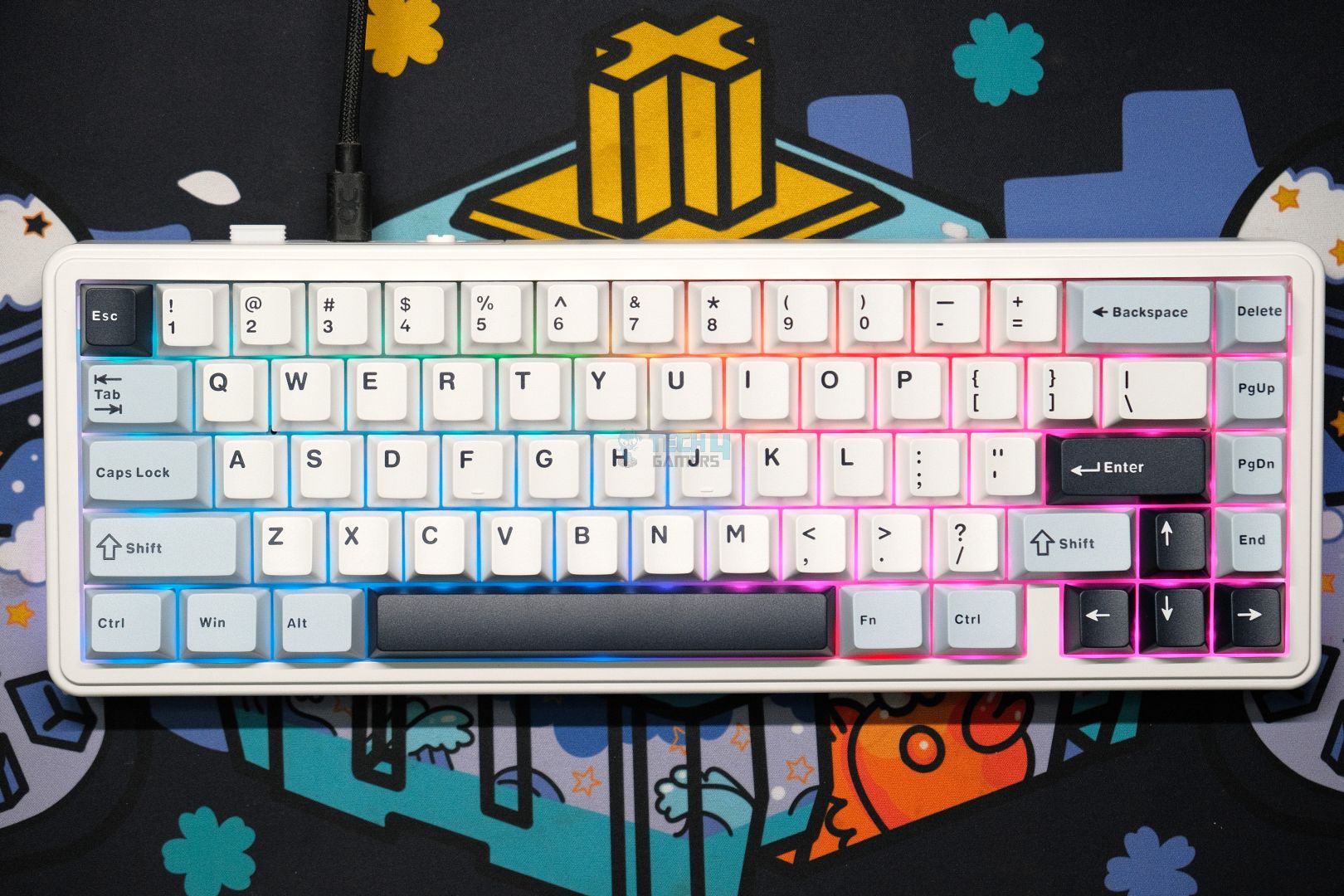
My Thoughts
The Aula F65 is another solid entry into Aula’s lineup of F-series keyboards, and it stands tall amongst the myriads of budget keyboards out there. But with faltering wireless performance, no extras like a volume knob to make it stand out, and unintuitive software, this is certainly not the best budget 65% keyboard you can get.
I would highly suggest saving up just a bit more and opting for a fully custom Lucky65 build or a prebuilt Womier SK65 or even a Yunzi AL-series keyboard if you’re after this form factor. Otherwise, stick with the Aula F75 or F87 Pro if you want a more reliable experience. If you crave a bit of novelty, the Epomaker Shadow-X is another great option.
What Others Are Using?
Thank you! Please share your positive feedback. 🔋
How could we improve this post? Please Help us. 😔
Born and raised around computers, Huzaifa is an avid gamer and a keyboard enthusiast. When he’s not solving the mysteries of technology, you can find him obsessing over semiconductors, striving to inform the curious.
He’s been modding tech since forever and knows a thing or two about what makes a great typing experience, making him the perfect expert to rely on for your keyboard recommendations! With his IT certification from Google, you can trust him to advise you with deliberation and integrity.
- Favorite Prebuilt: Epomaker P75
- Favorite Budget Option: Tecware Spectre 75
- Favorite Custom Keyboard: TKD Cycle7 / Lucky65 V2


 Threads
Threads


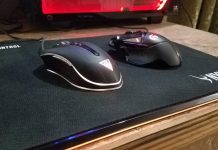
![Best White Gaming Mouse [Hands-On-Tested] Best White Gaming Mouse](https://tech4gamers.com/wp-content/uploads/2023/06/Best-White-Gaming-Mouse-.jpg)
